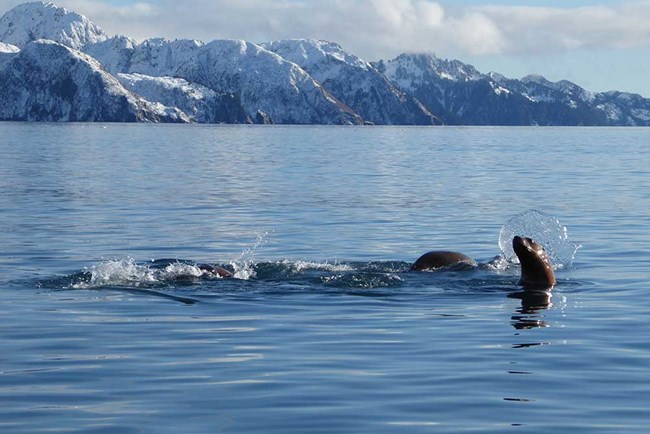Last updated: September 15, 2021
Article
Counting Sea Lions

Estimating animal populations is a challenge, especially for highly mobile animals that spend a good portion of their time underwater. Steller sea lions are a common sight in Glacier Bay National Park and Preserve and are monitored using aerial photographic surveys at land-based sites, where animals come ashore for resting, pupping, molting, and to avoid predators. Although these counts form the basis for monitoring population change over time, they do not provide information regarding where animals occur in the water, which is often of management and conservation interest.
This study developed a model that combined counts of sea lions from aerial photographic surveys with opportunistic sightings of sea lions in the water from a small vessel between 2000 and 2017. The model estimated the abundance of Steller sea lions at the primary terrestrial site at South Marble Island and then characterized the spatial distribution in the water in Glacier Bay. The model will form a part of a larger structured decision-making tool currently in development for managing wildlife protection and visitors in Glacier Bay National Park and Preserve.
Modelling pinniped abundance and distribution by combining counts at terrestrial sites and in-water sightings
Abstract
Pinnipeds are commonly monitored using aerial photographic surveys at land- or ice-based sites, where animals come ashore for resting, pupping, molting, and to avoid predators. Although these counts form the basis for monitoring population change over time, they do not provide information regarding where animals occur in the water, which is often of management and conservation interest. In this study, we developed a hierarchical model that links counts of pinnipeds at terrestrial sites to sightings-at-sea and estimates abundance, spatial distribution, and the proportion of time spent on land (attendance probability). The structure of the model also allows for the inclusion of predictors that may explain variation in ecological and observation processes. We applied the model to Steller sea lions (Eumetopias jubatus) in Glacier Bay, Alaska using counts of sea lions from aerial photographic surveys and opportunistic in-water sightings from vessel surveys. Glacier Bay provided an ideal test and application of the model because data are available on attendance probability based on long-term monitoring. We found that occurrence in the water was positively related to proximity to terrestrial sites, as would be expected for a species that engages in central-place foraging. The proportion of sea lions in attendance at terrestrial sites and overall abundance estimates were consistent with reports from the literature and monitoring programs. The model we describe has benefit and utility for park managers who wish to better understand the overlap between pinnipeds and visitors, and the framework that we present has potential for application across a variety of study systems and taxa.
Whitlock, S. L., J. N. Womble, J. N. and J. T. Peterson. 2020. Modelling pinniped abundance and distribution by combining counts at terrestrial sites and in-water sightings. Ecological Modelling 420:108965
